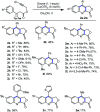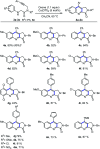Oxone promoted dehydrogenative Povarov cyclization of N-aryl glycine derivatives: an approach towards quinoline fused lactones and lactams
- PMID: 35530246
- PMCID: PMC9072217
- DOI: 10.1039/c9ra06212b
Oxone promoted dehydrogenative Povarov cyclization of N-aryl glycine derivatives: an approach towards quinoline fused lactones and lactams
Abstract
Oxone promoted intramolecular dehydrogenative imino Diels-Alder reaction (Povarov cyclization) of alkyne tethered N-aryl glycine esters and amides has been explored, thus affording biologically significant quinoline fused lactones and lactams. The reaction is simple, scalable, and high yielding (up to 88%). The method was further extended to prepare biologically important luotonin-A analogues and the quinoline core of uncialamycin.
This journal is © The Royal Society of Chemistry.
Conflict of interest statement
There are no conflicts to declare.
Figures







Similar articles
-
Radical Cation Salt-Promoted Catalytic Aerobic sp(3) C-H Oxidation: Construction of Quinoline-Fused Lactones and Lactams.J Org Chem. 2015 Jan 2;80(1):609-14. doi: 10.1021/jo502184k. Epub 2014 Dec 15. J Org Chem. 2015. PMID: 25470759
-
Visible-Light-Induced Photocatalytic Aerobic Oxidation/Povarov Cyclization Reaction: Synthesis of Substituted Quinoline-Fused Lactones.J Org Chem. 2016 Oct 7;81(19):8770-8776. doi: 10.1021/acs.joc.6b01253. Epub 2016 Jul 27. J Org Chem. 2016. PMID: 27431671
-
Intramolecular imino Diels-Alder reaction: progress toward the synthesis of uncialamycin.J Org Chem. 2009 Sep 4;74(17):6728-34. doi: 10.1021/jo901291t. J Org Chem. 2009. PMID: 19637842
-
Oxidative Tandem Cyclization of Glycine Esters with Propargyl Alcohols.J Org Chem. 2023 Jul 21;88(14):10232-10241. doi: 10.1021/acs.joc.3c00627. Epub 2023 Jul 9. J Org Chem. 2023. PMID: 37422896
-
Advances in the Synthesis of Ring-Fused Benzimidazoles and Imidazobenzimidazoles.Molecules. 2021 May 4;26(9):2684. doi: 10.3390/molecules26092684. Molecules. 2021. PMID: 34064312 Free PMC article. Review.
Cited by
-
Recent Advances in the Oxone-Mediated Synthesis of Heterocyclic Compounds.Molecules. 2021 Dec 12;26(24):7523. doi: 10.3390/molecules26247523. Molecules. 2021. PMID: 34946605 Free PMC article. Review.
-
Recent Advances in the Research on Luotonins A, B, and E.Molecules. 2024 Jul 26;29(15):3522. doi: 10.3390/molecules29153522. Molecules. 2024. PMID: 39124927 Free PMC article. Review.
-
The Intramolecular Povarov Tool in the Construction of Fused Nitrogen-Containing Heterocycles.Top Curr Chem (Cham). 2023 May 30;381(4):20. doi: 10.1007/s41061-023-00428-7. Top Curr Chem (Cham). 2023. PMID: 37249641 Free PMC article. Review.
References
-
- Sharma R. Kour P. Kumar A. J. Chem. Sci. 2018;130:73. doi: 10.1007/s12039-018-1466-8. - DOI
- Solomon V. R. Lee H. Curr. Med. Chem. 2011;18:1488–1508. doi: 10.2174/092986711795328382. - DOI - PubMed
- Musiol R. Serda M. Hensel-Bielowka S. Polanski J. Curr. Med. Chem. 2010;17:1960. doi: 10.2174/092986710791163966. - DOI - PubMed
- Musiol R. Jampilek J. Kralova K. Richardson D. R. Kalinowski D. Podeszwa B. Finster J. Niedbala H. Palka A. Polanski J. Bioorg. Med. Chem. 2007;15:1280–1288. doi: 10.1016/j.bmc.2006.11.020. - DOI - PubMed
- Michael J. P. Nat. Prod. Rep. 2007;24:223–246. doi: 10.1039/B509528J. - DOI - PubMed
- Kouznetsov V. V. Mendez L. Y. V. Gomez C. M. M. Curr. Org. Chem. 2005;9:141–161. doi: 10.2174/1385272053369196. - DOI
-
- Boisse T. Gavara L. Gautret P. Baldeyrou B. Lansiaux A. Goossens J.-F. Hénichart J.-P. Rigo B. Tetrahedron Lett. 2011;52:1592–1596. doi: 10.1016/j.tetlet.2011.01.105. - DOI
- Jahng K. C. Kim S. I. Kim D. H. Seo C. S. Son J.-K. Lee S. H. Lee E. S. Jahng Y. Chem. Pharm. Bull. 2008;56:607–609. doi: 10.1248/cpb.56.607. - DOI - PubMed
- Cagir A. Eisenhauer B. M. Gao R. Thomas S. J. Hecht S. M. Bioorg. Med. Chem. 2004;12:6287–6299. doi: 10.1016/j.bmc.2004.08.052. - DOI - PubMed
- Lee E. S. Park J.-G. Jahng Y. Tetrahedron Lett. 2003;44:1883–1886. doi: 10.1016/S0040-4039(03)00080-7. - DOI
- Dallavalle S. Merlini L. Tetrahedron Lett. 2002;43:1835–1837. doi: 10.1016/S0040-4039(02)00140-5. - DOI
- Yadav J. S. Reddy B. V. S. Tetrahedron Lett. 2002;43:1905–1907. doi: 10.1016/S0040-4039(02)00135-1. - DOI
- Wang H. Ganesan A. Tetrahedron Lett. 1998;39:9097–9098. doi: 10.1016/S0040-4039(98)02004-8. - DOI
- Tseng M.-C. Chu Y.-W. Tsai H.-P. Lin C.-M. Hwang J. Chu Y.-H. Org. Lett. 2011;13:920–923. doi: 10.1021/ol1029707. - DOI - PubMed
- Kwon S. H. Seo H.-A. Cheon C.-H. Org. Lett. 2016;18:5280–5283. doi: 10.1021/acs.orglett.6b02597. - DOI - PubMed
-
- Nicolaou K. C. Wang Y. Lu M. Mandal D. Pattanayak M. R. Yu R. Shah A. A. Chen J. S. Zhang H. Crawford J. J. Pasunoori L. Poudel Y. B. Chowdari N. S. Pan C. Nazeer A. Gangwar S. Vite G. Pitsinos E. N. J. Am. Chem. Soc. 2016;138:8235–8246. doi: 10.1021/jacs.6b04339. - DOI - PubMed
- Nicolaou K. C. Chen J. S. Zhang H. Montero A. Angew. Chem., Int. Ed. 2008;47:185–189. doi: 10.1002/anie.200704577. - DOI - PubMed
- Nicolaou K. C. Zhang H. Chen J. S. Crawford J. J. Pasunoori L. Angew. Chem., Int. Ed. 2007;46:4704–4707. doi: 10.1002/anie.200700917. - DOI - PubMed
-
- Chen Q. Zhang S. Zhang T. He K. Yuan Y. Jia X. Asian J. Org. Chem. 2019;8:115–118. doi: 10.1002/ajoc.201800596. - DOI
- Liu Y. Q. Yang L. Tian X. Curr. Bioact. Compd. 2007;3:37. doi: 10.2174/157340707780126499. - DOI
- Gordaliza M. Garcia P. A. Miguel del Corral J. M. Castro M. A. Gomez-Zurita M. A. Toxicon. 2004;44:441. doi: 10.1016/j.toxicon.2004.05.008. - DOI - PubMed
- Feliciano A. S. Miguel del Corral J. M. Gordaliza M. Castro M. A. Phytochemistry. 1989;28:659–660. doi: 10.1016/0031-9422(89)80081-0. - DOI
-
- Blair A. Zmuda F. Malviya G. Tavares A. A. S. Tamagnan G. D. Chalmers A. J. Dewar D. Pimlott S. L. Sutherland A. Chem. Sci. 2015;6:4772–4777. doi: 10.1039/C5SC01647A. - DOI - PMC - PubMed
- Blair A. Stevenson L. Dewar D. Pimlott S. L. Sutherland A. MedChemComm. 2013;4:1461–1466. doi: 10.1039/C3MD00249G. - DOI
- Stevenson L. Tavares A. A. S. Brunet A. McGonagle F. I. Dewar D. Pimlott S. L. Sutherland A. Bioorg. Med. Chem. Lett. 2010;20:954–957. doi: 10.1016/j.bmcl.2009.12.061. - DOI - PubMed
- Anzini M. Cappelli A. Vomero S. Seeber M. Menziani M. C. Langer T. Hagen B. Manzoni C. Bourguignon J.-J. J. Med. Chem. 2001;44:1134–1150. doi: 10.1021/jm0009742. - DOI - PubMed
LinkOut - more resources
Full Text Sources

